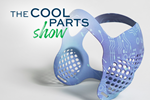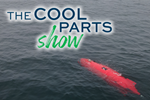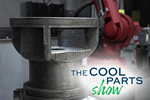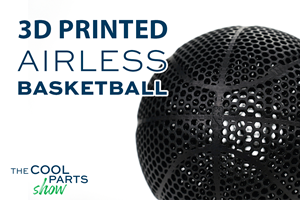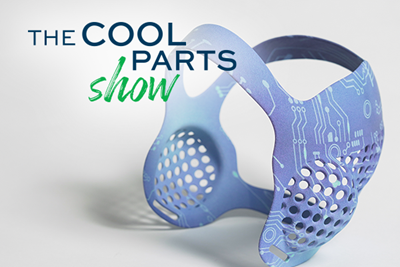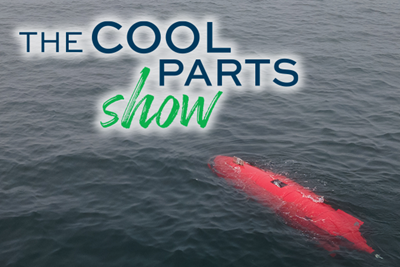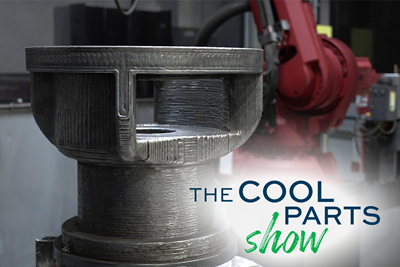The Cool Parts Show began as a five-episode, limited-run project in the fall of 2019, but has evolved into a continuously produced video series. Co-hosted by me and Peter Zelinski, each episode focuses on a 3D printed part that illustrates some way that additive manufacturing is already succeeding or soon will. Now in the summer of 2022, we’ve just posted the 50th episode of the show, featuring our largest metal part to date. In this episode of the AM Radio podcast, I sat down with my co-host and our videographer Austin Grogan to talk about the origins of the show and how it has evolved over the last few years; then, we share our favorite episodes.
Transcript
Peter Zelinski
We just posted our 50th episode of The Cool Parts Show. 50 cool parts. Stephanie is my co-host on the show. We're gonna talk about that on this episode of AM Radio.
Stephanie Hendrixson
The AM Radio podcast is brought to you by the Additive Manufacturing Conference at IMTS. The leading industry event focused on 3D printing for production. Learn more at AdditiveConference.com.
Peter Zelinski
Welcome to AM Radio where we tune in to what's happening in additive manufacturing. I'm Pete Zelinski, I am joined by Stephanie Hendrixson.
Stephanie Hendrixson
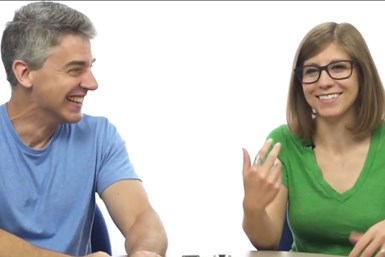
Peter Zelinski and Stephanie Hendrixson on an episode of The Cool Parts Show.
Hi, Pete.
Peter Zelinski
Stephanie. So this is a little bit meta. But let's use this show AM Radio to talk about another show, The Cool Parts Show.
Stephanie Hendrixson
That's right. So The Cool Parts Show is a video series that we've been producing since 2019. In every episode of the show, we highlight a cool, interesting, unique, innovative 3D printed part. And we talk about how it was made, why it's interesting, why it's important. We talk to the people who designed it, who made it. And we just, actually the day that we're recording this, we just posted our 50th episode of the show, our 50th cool part.
Peter Zelinski
Our 50th cool part. Some episodes of the show actually have multiple cool parts in them. So it's like actually, the tally is somewhere above 50 cool parts.
Stephanie Hendrixson
That’s true. Yeah.
Peter Zelinski
But our 50th episode, and we’ve been doing this show for three years now. And it has found a following. And we've found a lot of interesting parts made through additive manufacturing. And I just thought, it's worth a conversation for us to just kind of step back and maybe like, talk about what that means.
Stephanie Hendrixson
Yeah, I think we should do that. But real fast, just for listeners of this podcast, who may not have seen the show, you can find all of these episodes on YouTube at the Additive Manufacturing Media channel, and at thecoolpartsshow.com. So if you haven't seen the show, I highly recommend you check it out.
Peter Zelinski
So you introduced the show a little bit, you described a little bit what it is. I mean, where should we start?
Stephanie Hendrixson
I mean, let's start at the beginning. 2019, this crazy idea came from somewhere. What were we thinking back then, where why did we start the show?
Peter Zelinski
Right? And I want to resist the temptation to pretend like we knew what we were doing at the time. But a really, really simple idea. We have a small editorial team on Additive Manufacturing Media. And you know, we produce a lot of stuff that like we have a magazine, we do a conference. And we're starting to succeed with brief video content, too. And I think we just started to have a conversation about what else we could do. And it's a chance to show people the things being made with additive manufacturing. And it's sort of answered what I saw as a gap and a difficulty. There's a lot of talk with additive manufacturing, about the promise of it, what's possible, what's coming, like, like, what changes are going to come as a result, what's going to be realized, thanks to additive manufacturing, and it's all valid. But meanwhile, there is stuff being manufactured through 3D printing, or coming very close to being manufactured through 3D printing. And it seemed really valuable, just to hold that up in front of our audience and talk about that, point out those parts. And that was really the starting point of it.
Stephanie Hendrixson
Yeah, and I think what we had noticed in some of those earlier short videos is that in the cases where we were actually like holding something, we're holding a part or we were interacting with something, those were the ones that people tended to watch more of. And so like The Cool Parts Show has that sort of physicality, like we are interacting with the parts, we ask people to send them here to our studio, or we go to where the part is sometimes. And that interaction has stayed part of the show.
Peter Zelinski
And so you mentioned 2019, which is which is when we started and we're 50 episodes in. And we're also just about three years in maybe a little more because it was during the summer of 2019 that we made a drive to Columbus (Ohio), that was the very first thing we ever did related to pursuing this project. And so at that time, the idea that we would create this many episodes that it would become as sustaining as it has become now that we would get 50 episodes in. Like that was nowhere in my idea for this. I thought we'd do a batch of these and it would be fun, and it would be a thing and it would it would be what it was and like it was even a little bit of a surprise to us when we sort of started the second batch started the second season. We discovered that this model and these simple rules we have, every episode we talk about a part, it's got to be a real production part or a proof of concept that’s ready for production. It created something that is very easy to understand and fall into and answers directly the kind of curiosity that manufacturers have, who are watching additive right now and kind of wanting to learn the lessons that are being learned because they're getting ready to jump into it themselves.
Stephanie Hendrixson
Yeah. So you sort of started to get into this. But maybe we should just talk about the fact that we sort of do have rules for the show, and like what qualifies as a cool part. And like, this is an ongoing negotiation between you and me. But the part has to be something that's in production or something that could be a real product in production. What are the other things that what are the other characteristics of a cool part?
Peter Zelinski
Right, so we started this, and we chose the name that we did, and we knew we were going to be talking about parts. And I didn't really realize like we would have to kind of stakeout cool. Also, here's the thing about that, it maybe doesn't happen as much anymore, although it does still happen, which is 3D printing being promoted with objects that are artistic, or sort of visually interesting, or engaging in like a like a light on pop culture sense. And it like, it shows maybe geometrically what the printers are able to do, but it doesn't have engagement with the industrial applications that are the real promise of 3D printing. And like it even comes off a little patronizing if I'm being presented an Iron Man statue as why I should get excited about 3D printing, like no, I want to see a load bearing bracket. And so the load bearing bracket falls way closer to our definition of what cool is. So to be sure, we are going forward with a very specific and and esoteric definition of cool, but in my mind, it has to do with brackets, which hold the whole world together, and implants that are saving people's lives or the possibilities for their lives, or cars that get us to work or planes that bring cultures together. Or like as we'll see in our 50th episode, like stuff that helps people weld. You know, like that is what's cool. Like that is work. It is the real work that industry and our economy is doing. And additive manufacturing is rapidly stepping up and ballooning in its reach to take a role in how all that is done. And like cool is what we look for. And boy, there's there is a part of our definition of cool, that actively rejects the outwardly cool looking things. I think sometimes we're looking for functional stuff, taking nothing away from Iron Man. But…
Stephanie Hendrixson
Yeah, well, so we have a really specific definition of what cool is even though it's a little bit hard to articulate. But we also have kind of a specific definition of what a part is. So yeah, we've never done movie props, we've never done kind of art pieces, because they are you know, they're, they're visual, they're not something that is going into somebody's body or into a plane or into a car or something like that. And we've also kind of in the other direction, we've never done a tool. We've had people approach us with interesting molds and things that they've made. And by the definition of The Cool Parts Show, we want to talk about parts, we want to talk about the end use thing that's going out into the world.
Peter Zelinski
Yeah, and that's a, it's a subtle point. And it's a little bit inside baseball, but it's true. We don't do tooling. And and when you talk about industrial applications, additive manufacturing has a gigantic and important role to play in tooling, no totally. But it's The Cool Parts Show and trying to tell the story in a video episode, the way we do, if you're talking about a tool, we're reaching such a broad audience, that there are so many different steps to talk about, we can't really tell the story all that well, because you'd have to, you'd have to describe the process the tool is used for and then how that relates to the part that's made with the tool. And then from there, the thing we usually do, which is the role that the part itself plays in a larger product, this, The Cool Parts Show isn't the right vehicle for that. And so like we focus in on what the show can do really well.
Stephanie Hendrixson
Alright, so if those are the criteria of what makes something cool, and what makes it a part that we would cover on The Cool Parts Show, like let's talk about an example. Let's talk about the 50th episode. So this one is out on our website. It's out on YouTube, people can find it. What makes this particular instance like a good case of The Cool Parts Show, a good episode of The Cool Parts Show?
Peter Zelinski
Yeah, and I just want to tease it a little bit because I want people to watch it. It's a special episode. It's the biggest metal part we've gotten the chance to do an episode…
Stephanie Hendrixson
Like 500 pounds. Right?
Peter Zelinski
Right. So it's a, it's a bearing housing for a big piece of industrial equipment. So like it rings a lot of bells that are good for The Cool Parts Show. And like it would occur to nobody to think this big industrial part is cool. But it absolutely is because of the the vital work that it does. And it just shows that additive manufacturing isn't necessarily just a solution for new, modern, intricate, sophisticated performing and appearing objects. It is also a solution, a way to quickly get replacement parts for machines that are out there right now working well. It's like a solution and a support for all kinds of existing legacy industrial equipment, too. You talk to me, why is this a cool part?
Stephanie Hendrixson
Well, so it's a part, first of all, it's not a part that the public would ever see outside of the show. So this is for an internal piece of equipment used at Lincoln Electric. And it was a part that had been in use for a very long time, they found a problem with it, and they decided to replace it with, with 3D printing. But it's like you would never know about this story without going there and talking to them. But it is like a really important functional part. So it meets that qualification. Why is it cool? I think something we try to do on the show in that negotiation between you and me is we try to always cover new ground. Like we don't want to do an episode that hits all the same marks as an episode that we've done previously. And with this one, yeah, it was the biggest the biggest metal part that we'd ever done weighs like 500 pounds, we couldn't get it in the studio like that the logistics of that just weren't gonna work. So we had to go there and film. But more than that, like it gave us this chance to talk about legacy parts. And what do you do when you have this vital vital component? And there's no CAD for it, there's no blueprints, there's no drawings? Like there's no tooling? How do you replace it? And how can 3D printing fit into a workflow for replacing a component like that? And so that to me was the really cool thing about this part is just that we got a really good picture of of that workflow, how do you take what you already have, and then translate it into a digital file, and then 3D print it and get something that's functional, and replaces a casting and also makes that original part better at the end.
Peter Zelinski
So there's something I’m hearing in what you said, that is like this really important thing. And I get really excited about which is, we try to tell a new story every time. And I guess that's what really amazes me about how long the show has sustained and how far it's come, 50 episodes. It's not just that we found 50 plus additive manufactured parts, we have. It's also that we found 50 new and different stories to tell, there has never been a moment where we felt the need to go back and retell a type of story about a type of application, we already covered well in a preceding episode. And what it speaks to is The Cool Parts Show as it exists in this moment of time, in the season where additive manufacturing is moving so fast and continuing to change in ways that, we do keep on being presented with, keep on discovering new stories to tell about new things additive manufacturing is doing as it takes the next step like additive manufacturing is changing and, boy, the show has kind of changed to in three years, do you think?
Stephanie Hendrixson
Yeah, absolutely. So like thinking back to that that first batch of episodes, we did five of them all at once. And like we knew from the beginning that it was going to involve a part with that we wanted to have the part in the studio, we wanted to be able to interact with it. But we've also always had experts as sort of like guests on the show to come talk about this part that they designed that they printed that they worked on, or that they used in some way. And in that first batch of episodes, we filmed a lot of those interviews on location. And I think that was sort of the way we thought that this was going to play out. But of course, we put out our five episodes in 2019. And then I think we did a bonus one from Formnext. And then the world shut down the following year. And suddenly, we had to get really, really good at putting these episodes together with remote interviews. Like we tried a bunch of different video interviewing tools, we finally found one that was going to work for us. And it's actually, like, it's turned out to be a great thing for the show. It's allowed us to do episodes with where the experts are in Europe. We just recently posted our first episode from Africa with, with a team that was in South Africa. And so I think we've actually had a lot more opportunities and the show has grown geographically.
Peter Zelinski
The historical context of the show, like it, like it became a creature of COVID to an extent that of course we could never have anticipated, but most episodes like have played out within the pandemic. It seems so long ago now and it wasn't, but there was that series of time like, like we were very concerned with social distancing. And we were filming in a different way within the studio. So like all that happened, and you're right, we learned a lot of new things that we're just, we've just adopted and are using naturally now. Do you feel like the voice of the show has changed in any way?
Stephanie Hendrixson
I think it has, like, I think we started out on this assumption that we were talking to people who maybe weren't that familiar with 3D printing, or weren't that familiar with different types of 3D printing. I feel like we maybe spent more time explaining processes and stuff in the beginning. And also in that first batch of videos like the thumbnails and things we've tried to sort of obfuscate what the part was, like, we had that sort of like, ‘Who's that Pokemon’-style thumbnail at the beginning, where you couldn't see what the part was until you watched the episode. And actually, we discovered like, that's not really the hook, like people don't watch to find out what the part is, they watch to find out all the other stuff about the part and what it means.
Peter Zelinski
Yeah, we knew that we put a video series out on YouTube and the way we thought about it in that part, and this part of it was right, but we're like sort of holding a flag high for the additive manufacturing coverage we're doing, trying to attract and appeal to all those manufacturers out there who are either beginning to advance with additive or advancing toward additive. So yeah, we felt like we had to explain a lot. We've sort of gotten a sense of the level of knowledge that people bring to the show, which is still all over, but in the main, it's at a higher level than we were initially imagining. And we've sort of, the show has focused and, and become more sophisticated as a result of that.
Stephanie Hendrixson
Yeah. And you can sort of tell like, by the questions we get on YouTube, they're not basic questions, like what is laser powder bed fusion? We have a video all about that if you want to learn more, but the questions get into like some really interesting details about well, how was that part heat treated? And how was it finished? And how do they do this and that? People are really kind of diving into these episodes and wanting much deeper information sometimes.
Peter Zelinski
Alright, so we've been kind of having this conversation that's like this inside view of The Cool Parts Show and like behind the scenes, how it's done. Why don't maybe in the second half of the show, we go out in front of the scenes like maybe we talk about favorite episodes.
Stephanie Hendrixson
Yeah, so stay tuned. After the break, you and I will share our favorite episodes. And for the first time ever, we're going to hear from the third member of The Cool Parts Show team, our videographer Austin Grogan.
The AM Radio podcast is brought to you by the Additive Manufacturing Conference at IMTS. The leading industry event focused on 3D printing for production. Co-located with North America's largest trade show dedicated to manufacturing equipment, the AMC takes place September 14 and 15 at Chicago's McCormick Place. The Conference takes a practical applications-based look at the machines, materials and methodologies being used to 3D print functional components, including both tooling and end use production parts. The event is designed for owners, executives and engineers, as well as OEMs involved in durable goods manufacturing. Join the Additive Manufacturing team in Chicago for a day and a half of conference sessions and networking opportunities, find more information and register at AdditiveConference.com.
All right, and we're back. In the first half of the episode, we talked about The Cool Parts Show, where this idea came from, what makes a part cool. And in the second half, I've asked the three members of the team to all bring our favorite episodes to talk about. So you've heard from me, Stephanie, you've heard from my co-host, Pete. And now joining us in the studio is our videographer Austin Grogan. Hello, Austin.
Austin Grogan
Hello.
Peter Zelinski
Hey, Austin
Stephanie Hendrixson
It feels really weird to welcome you to the show because you're also involved in the podcast and you're always in the room for these tapings anyway, but this is the first time we're hearing you.
Austin Grogan
Always here, never seen or heard.
Peter Zelinski
It's like, that's an important point. The Cool Parts Show every single episode is the result of the creative work of three different people, only two of whom are visible in each episode. So to kind of honor that, like, let's, let's do the standard opening of the show, but leave room for one more voice.
Stephanie Hendrixson
I'm Pete. I'm Stephanie.
Austin Grogan
I'm Austin.
Peter Zelinski
Austin, tell us about yourself. What do you do?
Austin Grogan
Yeah, so in the broader sense, I am the Video Production Manager here at Gardner Business Media, the parent company of Additive Manufacturing Media. And I do pretty much all video production for our editorial brands, our events, our marketing, and we do some contract work in our custom content team. But more specifically for The Cool Parts Show, I film everything, I edit everything. Tell Pete and Steph that they need to do a shorter episode, do a longer episode. I create the thumbnails, I check out the analytics for the episode, see how they're doing and kind of give my insight on what I think we need to do in order to improve the show as we go forward.
Peter Zelinski
How did you first get involved in The Cool Parts Show three years ago? Because, you know, initially, at least in my mind, and I think Stephanie was here, too, like, like, we had very, very low aims for what we were trying to do. We were imagining doing this show on our phones, like, like filming it that way. At least that's how I was thinking about it. You kind of actually were the first of three of us to see, like, this idea had the potential to be something bigger.
Austin Grogan
Yeah. So this is one of my favorite stories, I love to tell it. Because Pete and Steph were just kind of off on their own deciding to create The Cool Parts Show. And I had no idea this was going on, which can be frustrating as the Video Production Manager.
Stephanie Hendrixson
We do go rogue sometimes. Sorry about that.
Austin Grogan
But we like to create videos, and there is only one of me. So sometimes, you know, Pete and Steph have to go out and make their own decisions. But I caught wind of this from another coworker just happened to mention that they were working on this project with cool parts. And I love the idea. I said, that needs to be a project that I'm on, we need to produce the crap out of this thing. And so I, probably the next day, either sent Pete and Stephanie and email or just showed up in their office, who knows, and mentioned that I heard about this project. And I thought that we should have a meeting to discuss how this project should be shaped going forward, and really try and add some more production value to it.
Peter Zelinski
Can we talk about Austin shaping our episodes?
Yeah, for sure.
So like, my favorite Austin contributions include the stealth cuts that he makes when he shows us a rough cut of the episode and just kind of quietly sees if he can get away with what he pulled out of it to make it tighter.
Stephanie Hendrixson
Oh, yeah. I mean, every time we film one of these, it goes on for too long. We say too many words. And Austin finds the way to just like, chop out the unnecessary bits in a way that sometimes I watched those those cuts, and I don't even notice.
Peter Zelinski
Austin, we were talking about how the show has changed. You are behind the camera, and then you're sitting with it and editing and producing it. Like, from your perspective, how have you seen it change?
Austin Grogan
Kind of, like you guys said, the episodes are longer. And, you know, I'm sure you can look at me with the face there, because I'm always telling you to make them shorter. But at the same time, I feel like that's a product of us letting the story tell itself. You know, we've realized that our audience is eager to learn that they're not turned away by deep dives into the technical information. And so we haven't been afraid to include that in our videos, which has allowed us to provide our audience with that, the information that they're looking for, and allowing them to learn. At the same time, on the technical, the video side of things, you know, we've gotten some new cameras, we've added some sound dampening to the studio, which has improved the quality of the videos, at least in my opinion. Again, this might be one of those stealth improvements that I generally am involved with, but in my mind, it's getting our videos closer and closer to that professional production grade product.
Stephanie Hendrixson
Okay, so Austin, you've been with the show since the beginning. So have Pete and I. So we've got 50 plus cool parts to pull from and I think it would be fun if we all just pick a favorite and talk about why it's your favorite. It could be because of the nature of the part. It could be something about the filming of the episode. Whatever qualifications you want to give it, we can all just go around the table and share our favorite episode.
Peter Zelinski
Sure, I guess the one I want to pick where I want to go with that, is, this is episode number 34. And it has to do with Dustless Technologies and how they're using additive manufacturing to produce the cool part we have in that episode, which is a 3D printed adapter that connects a wet dry vac to a demolition hammer like an industrial, a jackhammer used in construction.
Stephanie Hendrixson
Yeah, so meets the specification for a functional part. I think this might actually be our first cool part that's like available in a retail store that you can go buy it off the shelf, which is, which is pretty cool. That's right. And there was a really long lead time on this wasn't there?
Peter Zelinski
Yeah, not a long lead time on the part right, let’s be clear about that. But as far as how the story developed, yeah, like I heard from the owner of the company, Spencer Loveless, before he was into additive manufacturing in any way, exploring it, had the sense that this is where his production was going. And then the technology quickly made its next couple incremental steps and got to the point where in terms of rate and cost and material availability, it was just about there. And it made sense for some of his parts, some of his accessories to be made through additive manufacturing. And like, yeah, he just, he took the leap into additive in a big way. So I guess why it's my favorite. It illustrates a lot of big important transformations that we're seeing play out. Additive, like it changes who does manufacturing. Additive wants to locate close to where the product is being engineered and designed. And so Dustless became a manufacturer, a part producer on their own campus through reshoring, like another big development we're seeing, formerly he was locked into injection molding, using mold tooling that largely came from Asia. And there were all kinds of struggles he had with that lead time. And the sorts of delays costs and in flexibility that comes from long lead time was hampering his ability to innovate. There's just a nimbleness now of product introduction and service to his market that he's doing as a result of manufacturing additively.
Stephanie Hendrixson
Yeah, so it's been really interesting like to just see how this business has grown to the point that Spencer now has a second company Merit 3D that focuses on 3D printing as a service. And we did a follow up episode, a bonus episode about these custom pens that he made for us. And yeah, getting to a 3D printed pen that can be made in the United States for an affordable price is another cool thing that we got to learn about.
Peter Zelinski
So that's my favorite. What's your favorite episode?
Stephanie Hendrixson
Okay, my favorite episode is episode number 31, the custom jiu-jitsu helmet. So this part, it was a custom 3D printed polymer helmet. But if our listeners know anything about martial arts and jiu-jitsu, like a helmet is not usually a thing that you would wear to do this sport. But it was made for somebody special. Her name is Sarah Piersanti. And her whole family has been involved in martial arts and jiu-jitsu, specifically. But something happened, she lost her hearing, and she had to get a cochlear implant. And so like, there are a couple of different components to that device. But the critical one is that there's this processor that sits on top of her skull, but under her skin, it's really delicate, it needs to be protected. And so getting this implant restored her hearing, but it meant that she couldn't do jiu-jitsu anymore, she couldn't even do simple things like playing catch with her kids, because there's always that danger that that device is going to get hit and get damaged. And so she found an orthotist, Brent Wright, who was able to scan her head and help design this custom helmet that's made specifically to protect that processor. And then Brent was teamed up with Zac Holcomb and Additive America, which did the 3D printing, did the finishing. And we got to talk to all three of them for the episode. And they all brought really different things to the table. So like meeting Sarah was amazing. She's just a super cool person with a really interesting and inspiring story. Talking to Brent was fascinating, like the way that I think about 3D scanning and how the 3D scan does not equal the design. And there are these other things you need to understand to take a digital scan and make it into something that can be 3D printed, just really kind of informed my, my knowledge of that process. And then speaking with Zac was great, too, because we got to learn about more of the technical aspects of manufacturing, but also, like how do you build a business around making these large-ish and custom devices like prosthetic sockets and helmets, and orthotics and make them at an affordable price and keep your business running. There's just like, a lot going on in this episode, and getting the story from three different people and three different perspectives all at the same time. Like that's what makes it my favorite. I loved getting to talk to all three of them. And just the way that it all got woven together in the final cut of the episode I think is really great.
Peter Zelinski
My heart gets pulled by some of the stories that we do. We talked about ,so we've talked in this episode about like, what's a part and what's cool but but part of what we're exploring also in discovering is what is manufacturing and additive manufacturing allows the reach of what manufacturing does to leave behind a plant floor or a shop and like go straight to someone's life, go straight into someone's home. And so yeah, this, Sarah had a very specific and personal need and manufacturing solved it. But it was personalized manufacturing in a way 3D printing makes possible and it was even a solution sort of invented by all the parties that you mentioned. So Brent right, who appeared in the episode like like he'd used 3D printing to do helmets before. It had always been for infants, and Sarah showed up and he like knew she was interested in a helmet and he's like, ‘Okay, I don't see a baby.’ But she protecting her cochlear implant. And so he sort of came to understood the needs of that particular situation and, and devised a solution. And mass customization is another one of these big trends that we're seeing happen and that we get to explore on The Cool Parts Show but this one was a particularly personal and uplifting and life-changing version of a mass customized product.
Stephanie Hendrixson
Yeah, it sort of touched a nerve like we've heard from a number of people since that episode aired who are interested in in similar solutions, whether it's because they have a cochlear implant or some other case. And so I think, you know, that is mass customization, like part of the promise is that there are solutions to these problems that we might never have found or might never have come to accept that 3D printing is here and can deliver them now.
Peter Zelinski
All right, let's both look to Austin now.
Stephanie Hendrixson
I'm the most interested in this one, because I don't know, I think I maybe would have guessed that Pete's favorite was Dustless. I think you guys maybe would have known what my favorite was, but I'm really interested in Austin's pick and his reasoning here.
Peter Zelinski
Hey, Austin, what's your favorite episode?
Austin Grogan
Yeah, so my favorite is episode 24. It's the autonomous submarine or UAV. Underwater autonomous vehicle. Pete and I, we fight over this one a couple of times. I know he really likes this episode as well. My my favorite parts generally, are focused on the behind-the-scenes aspect of it, so he might be able to give a better perspective on the part itself. But this autonomous submarine has a fully 3D printed hull, printed on a Cincinnati BAAM machine at AES in Akron, Ohio. My favorite part about this episode is it was one of our early on-location shoots, we got to go up to AES in Akron, and speak with Austin Schmidt and Andrew Bader, and really connect with them and see their enthusiasm for having us there at their shop, filming on location, seeing us make the episode about their parts. And it led to cool opportunities. This episode we filmed inside of the BAAM machine. And I remember we showed up, we started setting up in front of it. And I think it was Austin comes over and he's like, ‘Do you want to get inside?’ And we're like, ‘We can do that?’ And sure enough, they have a, they made it so that we could get inside, film with the parts right in front of us inside of this enormous 3D printer. And it was great just seeing them get involved, get excited about the episode, they must have said like 20 times, ‘Oh, yeah, we can't wait for this to come out and see it.’ So just that aspect is great. But also being there and seeing these machines in action, seeing the parts being made. And being able to capture that in person, while it's happening allows me to get a variety of shots and just ultimately produce a nice visual aspect to the video.
Peter Zelinski
The autonomous sub episode and filming inside the printer was a lot of fun.
Stephanie Hendrixson
Yeah, it was like the parts were literally still on the build plate that were sitting behind them. And how many people can say that they've sat inside of BAAM, I don't know, maybe there's more than I think. But I thought that was a pretty cool experience.
Austin Grogan
It was also great, because I mean, there must have been multiple times where they came up, and were like, ‘Hey, do you want us to do this, we can do that for you.’ And it really helped to add more to the videos. We ended up, you know, filming a couple of other, you know, short-form videos while we were there just by Austin and Andrew’s other ideas that they had, that's the other aspect to these on-location videos is you get some input from those people that that actually were, have involvement in these parts.
Peter Zelinski
Isn't that really true? So we've been doing some more on-location filming, it's always fun and it produces like great episodes. And I don't want to pretend that we know what we're doing. We kind of don't and we're making up the show as we go and we get all of this enthusiastic participation from our hosts who come up with really great ideas to help us tell their story.
Stephanie Hendrixson
Yeah, so I said earlier about how like we had to learn how to do this show through a pandemic and we got pretty good at doing virtual interviews and that sort of thing, but like not to take anything away from the on-location filming that we've been able to do like those have been really neat experiences. Also at AES I got to ride the BAAM
platform like it was an elevator. It was the world's slowest elevator, but it was, it was like an opportunity that came about exactly, Austin what you're saying, like, because the people who do this work are, were standing right there. And, you know, we all collectively decided that this seemed like a fun thing to do that we could pull off. And like those opportunities only come if you're, if you're there in the place with the people.
Peter Zelinski
All right I, I think maybe we should wrap this up. Stephanie, you can edit this part out if you want to. But I just want to say like, we're at the 50th episode now at The Cool Parts Show. This thing turned into a bigger and better received and farther reaching and more sustaining thing than I ever would have thought. And it's because of you guys. It's because of YouTube. And I just want to say how grateful I am that you guys both have jumped into this project, this show and and the ways that we've gotten to work together. I have had a like a certain vision for the show and what it could be. And it's way bigger and better than that. And it's because of the mind and imagination and enthusiasm that you guys have brought to it. And I just want to express just how grateful I am for your talent and your enthusiasm and you're really being kind of up for anything and the ways that we we develop the show.
Stephanie Hendrixson
I don't know how to top that. I think maybe we should just end it here. So happy 50th episode.
Peter Zelinski
Happy 50th.
Austin Grogan
Wooo!
Stephanie Hendrixson
For anybody listening, if you've not seen The Cool Parts Show, if you have missed some of the episodes that we've talked about, you want to just check out the whole catalogue. Again, you can find those at TheCoolPartsShow.com. You can also find us on YouTube. And if you like the show, we hope you'll subscribe there. Tell a friend about it and let us know. Thanks for listening.
AM Radio is recorded with help from Austin Grogan and Seth Cooper. The show is edited by Alex Lytle and me, Stephanie Hendrixson. Our artwork is by Kate Bilberry. AM Radio and Additive Manufacturing Media are products of Gardner Business Media located in the Queen City, Cincinnati, Ohio. I'm Stephanie Hendrixson. Thanks for listening.
Related Content
Preassembled Turbojet Engine, 3D Printed in One Build: The Cool Parts Show #75
Turbojet engines typically consist of hundreds or thousands of parts, but this engine — 2023 winner of The Cool Parts Showcase for Best Proof of Concept — was 3D printed as just two pieces, with the monolithic rotor embedded inside the stationary engine shell.
Read More8 Cool Parts From Formnext 2023: The Cool Parts Show #65
New additive manufacturing technologies on display at Formnext were in many cases producing notable end-use components. Here are some of the coolest parts we found at this year’s show.
Read MoreUnderstanding PEKK and PEEK for 3D Printing: The Cool Parts Show Bonus
Both materials offer properties desirable for medical implants, among other applications. In this bonus episode, hear more from Oxford Performance Materials and Curiteva about how these companies are applying PEKK and PEEK, respectively.
Read MoreAirless Basketball Shows Promise of 3D Printed Lattices: The Cool Parts Show Bonus
Successfully matching the performance of a standard basketball demonstrates the control possible over the mechanical properties of digital materials.
Read MoreRead Next
3D Printed Headgear that Can Take a Hit: The Cool Parts Show #31
A custom helmet made via Multi Jet Fusion has allowed Sarah Piersanti to get back to practicing jiu-jitsu without fear of damaging her cochlear implant.
Read MoreAutonomous Underwater Vehicle With 3D Printed Hull: The Cool Parts Show #24
Our first episode of The Cool Parts Show from inside a 3D printer! Big Area Additive Manufacturing (BAAM) produces exterior components of a robot submarine and changes how this AUV is marketed.
Read More500-Pound Replacement Part 3D Printed by Robot: The Cool Parts Show #50
Our biggest metal cool part so far: Wire arc additive manufacturing delivers a replacement (and upgrade) for a critical bearing housing on a large piece of industrial machinery.
Read More
.png;maxWidth=2000;quality=70)
.jpg;width=70;height=70;mode=crop)
